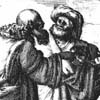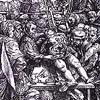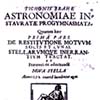
Science and Technology
The Library of Congress has assembled one of the world's largest and most diverse collections of scientific and technological literature and one that reflects Europe's centuries-old leadership role in many areas of science. Of the Library's four million scientific monographs amassed, most are written in English and other major European languages; between one-third and one-half are of European provenance. By and large, they are housed in the general collections. All fields are richly represented, excepting clinical medicine and technical agriculture, works of which are collected by the National Library of Medicine and the National Agricultural Library, respectively.
The Library has in its possession many of the early seminal European works pertaining to science. The Rare Book and Special Collections Division holds an original copy of Sir Francis Bacon's Instauratio Magna, popularly known as Novum organum (London, 1620), which proved persuasive in its explanation of the scientific method. Students of the history of science will be interested in the Library's complete first edition of the works of the Greek mathematician Archimedes, published in 1544 under the Latin title Opera, quae quidem extant, omnia. It is this publication that allowed Archimedes' largely forgotten essays, composed in the third century B.C., to leap across the centuries and inspire the mathematical pursuits of Galileo, Descartes, and Newton. In turn, many of the original publications of these three scientists are also available at the Library.
The literature of scientific societies is well represented, beginning with the earliest published records of the late seventeenth century--from the short-lived Accademia del Cimento in Italy, the Royal Society of London, Louis XIV's Académie des Sciences in France, and the Akademie der Wissenschaften in Berlin. The Library possesses impressive holdings from later societies and academies and actively seeks current materials from a large array of European institutions.
With the accelerated pace of information exchange, the research demand for periodical literature in the sciences has greatly outdistanced the demand for monographic works. Perhaps a third of the Library's collection of 61,000 scientific journals is from Europe. Thanks to the Smithsonian deposits from 1866 through 1941, the Library has extensive scientific serial publications from Europe for the nineteenth and first half of the twentieth century. The Library provides strong coverage up to the present of these and other types of scientific periodical literature, including conference proceedings. To aid the researcher in locating such frequently requested materials, numerous bibliographies, indexes, abstracts, and CD-ROM data bases can be found, particularly in the Science and Technology Reading Room.
 Petrus Apianus. Astronomicum caesareum
(Ingolstadt, 1540). One of the colorful astronomical charts called
"volvelles," containing movable plates, which are actually working astronomical
instruments still able to give accurate measurements. (Lessing
J. Rosenwald Collection, Rare
Book and Special Collections Division)
Petrus Apianus. Astronomicum caesareum
(Ingolstadt, 1540). One of the colorful astronomical charts called
"volvelles," containing movable plates, which are actually working astronomical
instruments still able to give accurate measurements. (Lessing
J. Rosenwald Collection, Rare
Book and Special Collections Division)
Jefferson's collection contained nearly 400 works from Europe devoted to natural philosophy, agriculture, chemistry, zoology, and the technical arts. It is evident from his correspondence that Jefferson examined these volumes closely. Among the extant works from his library is one by the French chemist Antoine Lavoisier, published in Paris in the revolutionary year of 1789 and entitled Traité élémentaire de chimie, présenté dans un ordre nouveau et d'après les découvertes modernes; avec figures. In a letter to a cousin of James Madison, Jefferson took issue with Lavoisier's new terminology, but nonetheless found chemistry "among the most useful of sciences, and big with future discoveries for the utility & safety of the human race."
The Library's holdings of materials relating to the hard sciences such as chemistry, physics, and astronomy are exceptionally strong, with several East European serial holdings unique to North America. An early holding in astronomy is the Tabulae astronomicae . . . of the Spanish king Alfonso the Wise, published in Venice in 1483. The most significant early work on the celestial bodies is arguably Nicolaus Copernicus's De revolutionibus orbium coelestium, Book 6, which rejected the earth-centered Ptolemaic concept. The Library possesses an original edition from 1543.
 Frontispiece
by Stefano della Bella to Galileo's Dialogo...sopra i due massimi
sistemi del mondo tolemaico, e copernicano (Fiorenza, 1632)
shows Aristotle, Ptolemy, and Copernicus discussing matters of astronomy.
It was the Dialogo and its open defense of Copernican heliocentrism that
occasioned Galileo's trial and his abjuration of the work itself. (Rare
Book and Special Collections Division)
Frontispiece
by Stefano della Bella to Galileo's Dialogo...sopra i due massimi
sistemi del mondo tolemaico, e copernicano (Fiorenza, 1632)
shows Aristotle, Ptolemy, and Copernicus discussing matters of astronomy.
It was the Dialogo and its open defense of Copernican heliocentrism that
occasioned Galileo's trial and his abjuration of the work itself. (Rare
Book and Special Collections Division)
European materials in the life sciences of botany, biology, and zoology are well represented in the collections of the Library of Congress, especially in the areas of genetics, microbiology, natural history, ecology, and animal behavior. The Library's psychology collections are quite strong, and include the papers of Sigmund Freud, discussed later. Also impressive are medical holdings from the nineteenth and first half of the twentieth century, before the National Library of Medicine assumed major responsibility for acquisitions in clinical medicine in the early 1950s. Likewise, agricultural literature is well represented until that time, when the Library of Congress deferred acquisition of technical agriculture and veterinary medicine to the National Agricultural Library.
The Library's efforts to acquire European materials pertaining to the earth sciences extend as far back as the purchase of Jefferson's library in 1815. The current European collections in this realm are quite strong, especially in mineralogy, stratigraphy, and other geologic fields, but also in such areas as geography, paleontology, biodiversity, environmental pollution, and environmental law. The extensive materials from Western Europe and Russia pertaining to arctic and alpine research form a large contribution to two ongoing bibliographies published by the Library's Science and Technology Division, the Bibliography on Cold Regions Science and Technology and the Antarctic Bibliography.
The holdings of the Library of Congress in literature pertaining to mathematics and computer science are impressive, including such fields as numerical analysis, cybernetics, and telecommunications. Particularly noteworthy are the extensive runs of Russian, Polish, and other European serials in these areas. The Russian forte in mathematics is reflected in the Library's extensive holdings of mathematics journals and monographs from that part of the world.
The Library of Congress collections of technological literature are at least as large as those pertaining to science. An early landmark of both theoretical scientific and technological literature was observed with the publication in eighteenth-century France of Denis Diderot's Encyclopédie ou Dictionnaire raisonné des sciences, des arts, et des métiers. The Library possesses a complete set of the first edition in seventeen volumes of text and eleven volumes of engravings.
The history and application of many areas of European technology are well represented in the Library's collections, such as electrical engineering, mechanical engineering, machinery, aeronautics, astronautics and photography, and especially chemical technology.
The Technical Reports Section of the Library's Science and Technology Division has amassed nearly four million technical reports, primarily on microfiche. Many of the earlier European technical reports after World War II pertained to atomic energy; more current reports focus on the environment, commercial applications, and technology transfer. There are regional strengths: the Finns and other Scandinavians, for example, produce technical reports important to construction research, whereas Dutch technical reports are strong in agriculture and the environment. Many European countries provide technical reports on mathematics and on information and computer sciences. Increased efforts are being expended to collect similar "gray" literature (literature not published through regular channels), often published in low press runs by European research institutes.
 Andreas Vesalius. De humani corporis
fabrica, libri septem (Basileae [Ex Officina I. Oporini, 1543]).
This publication of the young professor at Padua revolutionized the science
and teaching of anatomy, basing it on human rather than primate dissection.
(Lessing J. Rosenwald
Collection, Rare
Book and Special Collections Division)
Andreas Vesalius. De humani corporis
fabrica, libri septem (Basileae [Ex Officina I. Oporini, 1543]).
This publication of the young professor at Padua revolutionized the science
and teaching of anatomy, basing it on human rather than primate dissection.
(Lessing J. Rosenwald
Collection, Rare
Book and Special Collections Division)
Similarly, the Library strives to collect technical standards from selected industrialized countries. The Technical Reports Section maintains the only official hard-copy set of Soviet (now Russian) national standards to be found in North America, as well as microfilm copies of national standards for France, Germany, and Great Britain, and the integrated standards for the European Union.
A landmark for the Library came about with the acquisition of a collection of important documents on German industry, known as the FIAT and BIOS reports, acquired from Allied intelligence agencies shortly after World War II. These documents provide a clear picture of the nature of German technological advances prior to and during the war and demonstrate Nazi German industry's total orientation toward armaments production. They encompass a variety of captured German technical documentation, especially technical reports, but also patent applications from 1939 to 1945.
For all subjects, the Library of Congress seeks to acquire translations from foreign languages into English only. To meet the high demand for translations of scientific literature, the Library has collected hundreds of thousands of documents in this area. For example, extensive runs of the Joint Publications Research Service, consisting primarily of translations of technical literature from the former Soviet bloc, and of commercially produced, cover-to-cover translations of Western European and Russian scientific journals are available in the collections.
 Tycho de Brahe. Astronomiae instauratae
progymnasmata (Prague, 1602), title page. The first of a projected
three volumes on recent astronomical phenomena, this volume reproduces
Brahe's "De nova stella" of 1572, based on accurate observations and representing
the modern scientific method. (Rare
Book and Special Collections Division)
Tycho de Brahe. Astronomiae instauratae
progymnasmata (Prague, 1602), title page. The first of a projected
three volumes on recent astronomical phenomena, this volume reproduces
Brahe's "De nova stella" of 1572, based on accurate observations and representing
the modern scientific method. (Rare
Book and Special Collections Division)
Library of Congress ( October 6, 2005 ) Ask a Librarian |
LC Home Page | Search the LC Catalog | European Reading Room |